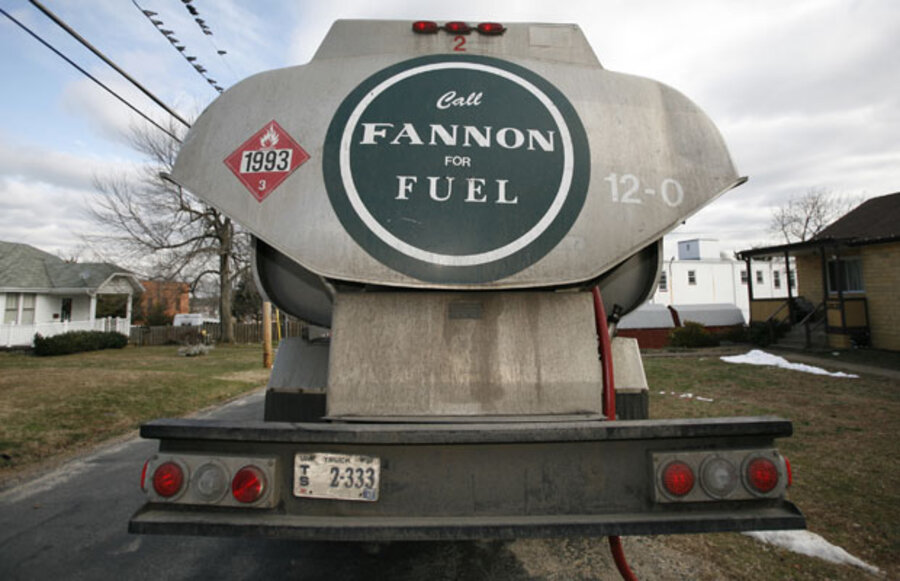Heating oil: a last stand in the Northeast?
Loading...
It’s getting hard to justify using oil heat, even in the Northeast, where the fossil fuel is making its last stand in the home-heating market.
The gap between heating oil and natural gas prices has grown so large – the biggest in at least a decade – that the incentive to convert to cheaper natural gas keeps growing. While it can cost $10,000 or more for a homeowner to make the switch, conversions appear to be on the rise. Some states are trying to make it easier for homeowners to convert, touting efficiency gains and emissions reductions. But the oil-heat industry isn't giving up without a fight.
The latest battleground is Connecticut. Gov. Dannel Malloy wants to extend gas lines to provide more than 300,000 customers the option to stick with oil or switch to natural gas, which would more than halve winter heating costs. Oil service companies, often small family-owned concerns, call his plan favoritism.
"They're using state resources to eliminate jobs, delivery drivers, customer service representatives," Stephen G. Rosentel, head of a family-owned home heating business in Danbury, told the Associated Press. "These are real jobs and real people, and they matter."
A loss of 300,000 customers would halve the oil-service companies' customer base. And there's no guarantee that always volatile natural gas prices won't go up in the future, they point out.
The oil-heating industry has had a tough go. In 1980, 20 percent of US homes used oil as their primary source of heat; by 2009, that was down to 6 percent, according to the latest survey from the Energy Information Administration (EIA). The consolidation means that only in the Northeast, where gas mains are less common, does the industry retain any significant customer base, and even that is eroding.
It’s easy to see why. Last winter, despite abnormally high temperatures, it cost the average homeowner $2,087 to heat his home with oil. It cost only $832 for the average Northeast homeowner to heat his home with gas, according to the EIA. This year, that $1,250 gap will widen to $1,500 as oil heating prices hit new highs: $2,525 for oil vs. $1,024 for natural gas, the EIA forecasts.
"The real story is what's happened in the last 10 years," says Tancred Lidderdale, a senior economist with the EIA. The price of heating oil has more than doubled, while the price of natural gas has hardly budged at all as US gas production continues to grow.
Conversions to natural gas appear to be picking up speed.
New Jersey Natural Gas last month cited steady customer growth as a key driver of its improved earnings. It converted 6,700 customers to gas in fiscal 2012, with 57 percent converting from other fuels, and expects that pace to continue over its next two fiscal years. In November, UIL Holdings Corp., based in New Haven, Conn., said gas conversions were running 55 percent ahead of 2011 levels. Unlike neighboring Massachusetts and Rhode Island, where nearly half of homes use natural gas for hear, just under a third use the fuel in Connecticut.
NStar told the Boston Globe in April that oil-to-gas conversions had tripled over the past three years; another regional utility, National Grid, reported a 34 percent increase over the same period.
In Maine, where access to natural gas is limited and until recently 80 percent of homes relied on oil heat, use of liquid propane more than doubled between 2004 and 2009, Ken Fletcher, director of the Governor's Energy Office, told the Sun Journal in Lewiston last month. He estimates that residential use has doubled again since that time, even though propane is a little more expensive than oil in the Northeast, according to the EIA.
It’s worth noting that natural gas burns more cleanly than oil and produces about 30 percent less carbon dioxide per Btu than conventional or ultra low sulfur heating oil, according to a 2009 study by Brookhaven National Laboratory in Upton, N.Y. Nationally, the US has already reaped most of the climate gains as the share of oil heated homes has fallen so dramatically. For the Northeast, there’s still an opportunity to cut CO2 emissions.








